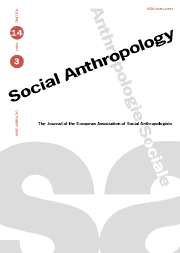Normalising racial boundaries. The Norwegian dispute about the term neger
Published online by Cambridge University Press: 22 February 2005
Abstract
This article presents a contextualised, interpretative analysis of the debate about the word neger that took place in the Norwegian mass media during the winter of 2000–01. The aim is to contribute ethnographic material and analytical perspectives to the comparative analysis of the current reinforcement of ethnic national boundaries as a reaction to extra-European immigrants to Europe and the accompanying normalisation of racial discourses. On the one hand, Norwegian mainstream reaction draws on the same sort of racial ideas and boundary-constructing practices found in other European countries. On the other, the contributors to the debate drew on a complex set of discourses and exhibited particular points of emphasis. For many majority Norwegians a specific collective memory and a corresponding national self-image are currently at stake. In this self-image Norway is always outside imperialism and colonialism, and innocent in relation to the colonial legacy. The analytical argument of the paper is that when people construct racial boundaries, they draw on a mixture of discourses, rooted in different social realms, with different histories and degrees of legitimacy. The self-evidence of racial categories derives from the legitimacy of well established historical themes, concepts and lines of conflict. As the debate about the word neger unfolded over time, majority hegemony was challenged, rearticulated and reconfirmed.
Cet article présente une analyse d'interprétation en contexte d'un débat autour du mot neger ayant eu lieu dans les media de masse norvégiens pendant l'hiver 2000–01. Le but de l'analyse est d'apporter des ressources ethnographiques et des perspectives analytiques à l'analyse comparative du renforcement actuel des frontières nationales et ethniques qui se produit en réaction à l'immigration extra-européenne, et à la normalisation des discours raciaux qui s'en suit. D'une part, la réaction norvégienne majoritaire s'inspire d'idées à propos des races, et des pratiques de construction de frontières similaires à celles des autres pays européens. D'autre part, les participants au débat se sont inspirés d'un ensemble complexe de discours et ont mis en avant certains points: pour une grande majorité des Norvégiens sont en jeu à la fois une mémoire collective spécifique et l'image nationale correspondante. Dans cette image d'elle-même, la Norvège s'est toujours pensée hors de l'impérialisme et du colonialisme, innocente par rapport à l'héritage colonial. L'argument analytique de l'article est que quand les gens construisent des barrières raciales, ils puisent dans un mélange de discours qui s'enracinent dans ces domaines sociaux différents, avec des histoires et des degrés de légitimité variables. L'évidence des catégories raciales provient de la légitimité de thèmes historiques, de concepts et de lignes de conflit bien établis. La façon dont le débat autour du mot neger s'est déployé dans le temps a remis en question, réarticulé et reconfirmé l'hégémonie de la majorité.
Dieser Artikel besteht in einer kontextbezogenen, interpretierenden Analyse einer Debatte um die Bezeichnung ‘Neger’, die in den norwegischen Massenmedien im Winter 2000–01 ausgetragen wurde. Das Ziel der Analyse ist ein Beitrag in Form von ethnographischem Material und analytischen Perspektiven zur vergleichenden Studie der gegenwärtig verstärkt auftretenden, ethnisch-nationalen Abgrenzung. Diese ist als Reaktion auf die außereuropäischen Einwanderer in Europa und die damit einhergehende Verselbstverständlichung von Rassendiskursen zu verstehen. Einerseits geht die norwegische Durchschnittsreaktion aus den gleichen Rassenideen und Grenzziehungsstrategien hervor wie sie auch in anderen europäischen Ländern vorherrschen. Andererseits schöpften die an der Debatte Beteiligten aus einer komplexen Reihe von Diskursen, während bestimmte Punkte immer wieder betont wurden: Für viele Mehrheitsnorweger steht eine spezifische, kollektive Erinnerung sowie ein nationales Selbstbild, das aus dieser hervorgeht, am Spiel. Das norwegische Selbstbild lag immer außerhalb von Imperialismus sowie Kolonialismus und steht in Bezug zum kolonialen Vermächtnis in Unschuld. In diesem Text wird analytisch dargelegt wie Rassenabgrenzung auf einer Mischung aus in verschiedenen Sozialbereichen verwurzelten Diskursen mit unterschiedlichen Geschichtsschreibungen und Berechtigungsgraden beruht. Das Selbstverständnis von Rassenkategorien ist auf die akzeptierte Rechtmäßigkeit althergebrachter historischer Themen, Konzepte und Konflikte zurückzuführen. In der fortschreitenden Debatte über den Begriff ‘Neger’ wurde die Mehrheitshegemonie angefochten, neuartikuliert und wiederbestätigt.
Este artículo presenta un análisis contextual, interpretativo, del debate sobre la palabra neger que tuvo lugar en los medios de comunicación noruegos durante el invierno del 2000–01. El objetivo del análisis es contribuir con material etnográfico y perspectivas analíticas al estudio comparativo del actual endurecimiento de las fronteras étnico-nacionales, así como de la actitud hacia inmigrantes no europeos en Europa y la consecuente normalización de discursos raciales. Por un lado, la reacción dominante noruega se centra en ideas raciales similares y en prácticas que levantan fronteras-como sucede en otros países europeos. Por otro lado, los que participaron en el debate se centraron sobre un complejo conjunto de discursos, y mostraron particulares puntos de atención: para muchos de los noruegos promedio, su memoria colectiva distintiva y la consecuente auto-representación nacional se encuentran en peligro. En esta auto-representación Noruega siempre ha sido ajena al imperialismo y colonialismo, y es inocente con respecto a la herencia colonial. El argumento analítico de este documento es que al construir fronteras raciales, la gente se basa en una mezcla de discursos, enraizados en diferentes dominios sociales, con diferentes historias y grados de legitimidad. La auto-evidencia de las categorías raciales se deriva de la legitimidad de temas históricos, conceptos y líneas de conflicto preestablecidas. Al pasar el tiempo, en el desarrollo del debate sobre la palabra neger, la mayoría dominante fue desafiada, rearticulada y reconfirmada.
- Type
- Research Article
- Information
- Copyright
- © Cambridge University Press 2005
Footnotes
- 32
- Cited by




